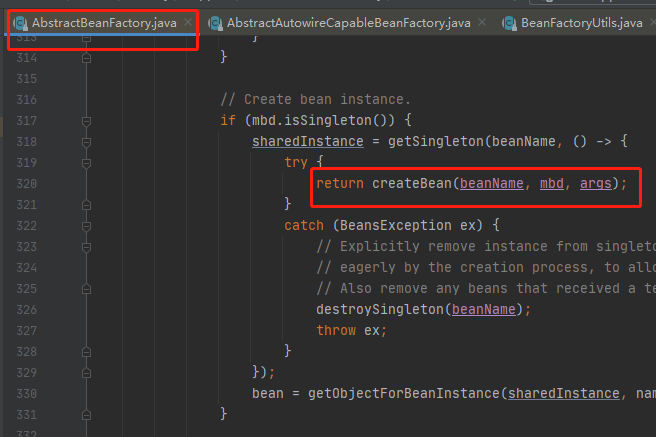一次性讲清楚spring中bean的生命周期之三:bean是如何实例化的
在前面的两篇博文《一次性讲清楚spring中bean的生命周期之一:getSingleton方法》和《一次性讲清楚spring中bean的生命周期之二:FactoryBean的前世今生》中分析了spring中bean生命周期的过程中的getSingleton方法和getObjectForBeanInstance方法,今天来分析另外一个重要的方法createBean方法。分析的入口是AbstractBeanFacotry.doGetBean方法,如下图,

这就是本次分析的入口。下面看该方法的详细定义,AbstractAutowireCapableBeanFactory.createBean
@Override
protected Object createBean(String beanName, RootBeanDefinition mbd, @Nullable Object[] args)
throws BeanCreationException { if (logger.isTraceEnabled()) {
logger.trace("Creating instance of bean '" + beanName + "'");
}
RootBeanDefinition mbdToUse = mbd; // Make sure bean class is actually resolved at this point, and
// clone the bean definition in case of a dynamically resolved Class
// which cannot be stored in the shared merged bean definition.
Class<?> resolvedClass = resolveBeanClass(mbd, beanName);
if (resolvedClass != null && !mbd.hasBeanClass() && mbd.getBeanClassName() != null) {
mbdToUse = new RootBeanDefinition(mbd);
mbdToUse.setBeanClass(resolvedClass);
} // Prepare method overrides.
try {
mbdToUse.prepareMethodOverrides();
}
catch (BeanDefinitionValidationException ex) {
throw new BeanDefinitionStoreException(mbdToUse.getResourceDescription(),
beanName, "Validation of method overrides failed", ex);
} try {
// Give BeanPostProcessors a chance to return a proxy instead of the target bean instance.
//给beanPostProcessor一个返回目标类代理类的机会
Object bean = resolveBeforeInstantiation(beanName, mbdToUse);
if (bean != null) {
return bean;
}
}
catch (Throwable ex) {
throw new BeanCreationException(mbdToUse.getResourceDescription(), beanName,
"BeanPostProcessor before instantiation of bean failed", ex);
} try {
//执行doCreatBean方法
Object beanInstance = doCreateBean(beanName, mbdToUse, args);
if (logger.isTraceEnabled()) {
logger.trace("Finished creating instance of bean '" + beanName + "'");
}
return beanInstance;
}
catch (BeanCreationException | ImplicitlyAppearedSingletonException ex) {
// A previously detected exception with proper bean creation context already,
// or illegal singleton state to be communicated up to DefaultSingletonBeanRegistry.
throw ex;
}
catch (Throwable ex) {
throw new BeanCreationException(
mbdToUse.getResourceDescription(), beanName, "Unexpected exception during bean creation", ex);
}
}
重点部分已用红色标出,下面具体来分析
bean生命周期前
在上面的方法定义中有这样一段代码,
// Give BeanPostProcessors a chance to return a proxy instead of the target bean instance.
Object bean = resolveBeforeInstantiation(beanName, mbdToUse);
就是说在进入bean的创建之前,开发者可以自己返回一个目标类的代理类,如果返回了那么便直接返回,不会继续向下执行。看该方法怎么实现的,AbstractAutowireCapableBeanFactory.resolveBeforeInstantiation
@Nullable
protected Object resolveBeforeInstantiation(String beanName, RootBeanDefinition mbd) {
Object bean = null;
if (!Boolean.FALSE.equals(mbd.beforeInstantiationResolved)) {
// Make sure bean class is actually resolved at this point.
if (!mbd.isSynthetic() && hasInstantiationAwareBeanPostProcessors()) {
Class<?> targetType = determineTargetType(beanName, mbd);
if (targetType != null) {
//应用BeanPostProcessor实例化前
bean = applyBeanPostProcessorsBeforeInstantiation(targetType, beanName);
if (bean != null) {
//应用BeanpPostProcessor初始化后
bean = applyBeanPostProcessorsAfterInitialization(bean, beanName);
}
}
}
mbd.beforeInstantiationResolved = (bean != null);
}
return bean;
}
该方法重要的就是applyBeanPostProcessorsBeforeInstantiation和applyBeanPostProcessorsAfterInitalization方法。
applyBeanPostProcessorsBeforeInstantiation
@Nullable
protected Object applyBeanPostProcessorsBeforeInstantiation(Class<?> beanClass, String beanName) {
for (BeanPostProcessor bp : getBeanPostProcessors()) {
//在spring中有InstantiationAwareBeanPostProcessor的实例,则执行其postProcessBeforeInstantiation方法
if (bp instanceof InstantiationAwareBeanPostProcessor) {
InstantiationAwareBeanPostProcessor ibp = (InstantiationAwareBeanPostProcessor) bp;
Object result = ibp.postProcessBeforeInstantiation(beanClass, beanName);
if (result != null) {
return result;
}
}
}
return null;
}
该方法的主要作用是如果在spring中有InstantiationAwareBeanPostProcessor类型的beanPostProcessor的化,会执行其postProcessBeforeInstantiation方法,也就是我们可以实现InstantiationAwareBeanPostProcessor接口,并实现其postProcessBeforeInstantiation方法。默认情况下该接口的方法返回null,
@Nullable
default Object postProcessBeforeInstantiation(Class<?> beanClass, String beanName) throws BeansException {
return null;
}
applyBeanPostProcessorsAfterInitalization
回过头来看另外一个方法,
@Override
public Object applyBeanPostProcessorsAfterInitialization(Object existingBean, String beanName)
throws BeansException { Object result = existingBean;
//遍历spring容器中所有的beanPostProcessor,执行其postProcessAfterInitialization方法
for (BeanPostProcessor processor : getBeanPostProcessors()) {
Object current = processor.postProcessAfterInitialization(result, beanName);
if (current == null) {
return result;
}
result = current;
}
return result;
}
BeanPostProcessor接口中该方法默认返回如下
@Nullable
default Object postProcessAfterInitialization(Object bean, String beanName) throws BeansException {
return bean;
}
在spring容器中会有多少BeanPostProcessor这个后面会分析。
分析完了进入bean生命周期前的方法,也就是留个开发者一个后门,通过实现InstantiationAwareBeanPostProcessor接口中的postProcessBeforeInstantiation方法可以自定义返回一个目标类型的代理对象。现在回到createBean方法中,真正进入bean的生命周期,看doCreateBean方法,
doCreateBean
该方法的篇幅过长,仅保留关键代码,其他代码删除,请知悉,
protected Object doCreateBean(final String beanName, final RootBeanDefinition mbd, final @Nullable Object[] args)
throws BeanCreationException { // Instantiate the bean.
BeanWrapper instanceWrapper = null;
if (mbd.isSingleton()) {
instanceWrapper = this.factoryBeanInstanceCache.remove(beanName);
}
if (instanceWrapper == null) {
//实例化bean
instanceWrapper = createBeanInstance(beanName, mbd, args);
}
final Object bean = instanceWrapper.getWrappedInstance();
Class<?> beanType = instanceWrapper.getWrappedClass();
if (beanType != NullBean.class) {
mbd.resolvedTargetType = beanType;
} .... // Eagerly cache singletons to be able to resolve circular references
// even when triggered by lifecycle interfaces like BeanFactoryAware.
boolean earlySingletonExposure = (mbd.isSingleton() && this.allowCircularReferences &&
isSingletonCurrentlyInCreation(beanName));
if (earlySingletonExposure) {
if (logger.isTraceEnabled()) {
logger.trace("Eagerly caching bean '" + beanName +
"' to allow for resolving potential circular references");
}
//放到singletonFactory中解决循环依赖的问题
addSingletonFactory(beanName, () -> getEarlyBeanReference(beanName, mbd, bean));
} // Initialize the bean instance.
Object exposedObject = bean;
try {
//属性注入
populateBean(beanName, mbd, instanceWrapper);
//初始化bean
exposedObject = initializeBean(beanName, exposedObject, mbd);
}
catch (Throwable ex) {
if (ex instanceof BeanCreationException && beanName.equals(((BeanCreationException) ex).getBeanName())) {
throw (BeanCreationException) ex;
}
else {
throw new BeanCreationException(
mbd.getResourceDescription(), beanName, "Initialization of bean failed", ex);
}
} .... return exposedObject;
}
看createBeanInstance方法
createBeanInstance
该方法的定义如下,
protected BeanWrapper createBeanInstance(String beanName, RootBeanDefinition mbd, @Nullable Object[] args) {
// Make sure bean class is actually resolved at this point.
Class<?> beanClass = resolveBeanClass(mbd, beanName);
if (beanClass != null && !Modifier.isPublic(beanClass.getModifiers()) && !mbd.isNonPublicAccessAllowed()) {
throw new BeanCreationException(mbd.getResourceDescription(), beanName,
"Bean class isn't public, and non-public access not allowed: " + beanClass.getName());
}
Supplier<?> instanceSupplier = mbd.getInstanceSupplier();
if (instanceSupplier != null) {
return obtainFromSupplier(instanceSupplier, beanName);
}
//使用实例工厂或静态工厂的方式生成bean实例
if (mbd.getFactoryMethodName() != null) {
return instantiateUsingFactoryMethod(beanName, mbd, args);
}
// Shortcut when re-creating the same bean...
boolean resolved = false;
boolean autowireNecessary = false;
if (args == null) {
synchronized (mbd.constructorArgumentLock) {
if (mbd.resolvedConstructorOrFactoryMethod != null) {
resolved = true;
autowireNecessary = mbd.constructorArgumentsResolved;
}
}
}
if (resolved) {
if (autowireNecessary) {
return autowireConstructor(beanName, mbd, null, null);
}
else {
return instantiateBean(beanName, mbd);
}
}
// Candidate constructors for autowiring?
//检测是否有重写的构造方法
Constructor<?>[] ctors = determineConstructorsFromBeanPostProcessors(beanClass, beanName);
if (ctors != null || mbd.getResolvedAutowireMode() == AUTOWIRE_CONSTRUCTOR ||
mbd.hasConstructorArgumentValues() || !ObjectUtils.isEmpty(args)) {
return autowireConstructor(beanName, mbd, ctors, args);
}
// Preferred constructors for default construction?
//首选默认的构造方法
ctors = mbd.getPreferredConstructors();
if (ctors != null) {
return autowireConstructor(beanName, mbd, ctors, null);
}
// No special handling: simply use no-arg constructor.
//使用无参构造方法
return instantiateBean(beanName, mbd);
}
从上面的方法中可以看出实例化bean,其实就是使用类的构造方法来进行实例化,这里看下instantiateBean方法的过程,
instantiateBean
看该方法的定义,
protected BeanWrapper instantiateBean(final String beanName, final RootBeanDefinition mbd) {
try {
Object beanInstance;
final BeanFactory parent = this;
if (System.getSecurityManager() != null) {
beanInstance = AccessController.doPrivileged((PrivilegedAction<Object>) () ->
getInstantiationStrategy().instantiate(mbd, beanName, parent),
getAccessControlContext());
}
else {
//生成bean的实例
beanInstance = getInstantiationStrategy().instantiate(mbd, beanName, parent);
}
//构造一个beanWrapper对象
BeanWrapper bw = new BeanWrapperImpl(beanInstance);
initBeanWrapper(bw);
return bw;
}
catch (Throwable ex) {
throw new BeanCreationException(
mbd.getResourceDescription(), beanName, "Instantiation of bean failed", ex);
}
}
从上面的代码可以看到该方法中重要的就是下面这句
beanInstance = getInstantiationStrategy().instantiate(mbd, beanName, parent);
看下getInstantiationStrategy()方法返回什么,
/**
* Return the instantiation strategy to use for creating bean instances.
*/
protected InstantiationStrategy getInstantiationStrategy() {
return this.instantiationStrategy;
}
返回的是一个属性,
/** Strategy for creating bean instances. */
private InstantiationStrategy instantiationStrategy = new CglibSubclassingInstantiationStrategy();
是一个CglibSubclassingInstantiationStragegy对象,看其instantiate方法,由于CglibSubclassingInstantiationStrategy继承了SimpleInstantiationStrategy类,该方法在父类SimpleInstantiationStrategy中
@Override
public Object instantiate(RootBeanDefinition bd, @Nullable String beanName, BeanFactory owner) {
// Don't override the class with CGLIB if no overrides.
//如果没有使用lookup或replaced,不使用CGLIB重写该类
if (!bd.hasMethodOverrides()) {
Constructor<?> constructorToUse;
synchronized (bd.constructorArgumentLock) {
constructorToUse = (Constructor<?>) bd.resolvedConstructorOrFactoryMethod;
if (constructorToUse == null) {
final Class<?> clazz = bd.getBeanClass();
if (clazz.isInterface()) {
throw new BeanInstantiationException(clazz, "Specified class is an interface");
}
try {
if (System.getSecurityManager() != null) {
constructorToUse = AccessController.doPrivileged(
(PrivilegedExceptionAction<Constructor<?>>) clazz::getDeclaredConstructor);
}
else {
constructorToUse = clazz.getDeclaredConstructor();
}
bd.resolvedConstructorOrFactoryMethod = constructorToUse;
}
catch (Throwable ex) {
throw new BeanInstantiationException(clazz, "No default constructor found", ex);
}
}
}
return BeanUtils.instantiateClass(constructorToUse);
}
else {
// Must generate CGLIB subclass.
//使用cglib生成子类
return instantiateWithMethodInjection(bd, beanName, owner);
}
}
从上面可以看出有两种方式生成实例,使用反射的机制
return BeanUtils.instantiateClass(constructorToUse);
如果有lookup或replaced,使用cglib方式
return instantiateWithMethodInjection(bd, beanName, owner);
BeanUtils.instantiateClass(反射)
public static <T> T instantiateClass(Constructor<T> ctor, Object... args) throws BeanInstantiationException {
Assert.notNull(ctor, "Constructor must not be null");
try {
ReflectionUtils.makeAccessible(ctor);
return (KotlinDetector.isKotlinReflectPresent() && KotlinDetector.isKotlinType(ctor.getDeclaringClass()) ?
KotlinDelegate.instantiateClass(ctor, args) : ctor.newInstance(args));
}
catch (InstantiationException ex) {
throw new BeanInstantiationException(ctor, "Is it an abstract class?", ex);
}
catch (IllegalAccessException ex) {
throw new BeanInstantiationException(ctor, "Is the constructor accessible?", ex);
}
catch (IllegalArgumentException ex) {
throw new BeanInstantiationException(ctor, "Illegal arguments for constructor", ex);
}
catch (InvocationTargetException ex) {
throw new BeanInstantiationException(ctor, "Constructor threw exception", ex.getTargetException());
}
}
标红的代码就是生成的逻辑,可以看到是利用的java的反射机制,也就是使用Constructor类的newInstance方法。
instantiateWithMethodInjection(cglib)
该方法在CglibSubclassingInstantiationStrategy中
@Override
protected Object instantiateWithMethodInjection(RootBeanDefinition bd, @Nullable String beanName, BeanFactory owner) {
return instantiateWithMethodInjection(bd, beanName, owner, null);
}
@Override
protected Object instantiateWithMethodInjection(RootBeanDefinition bd, @Nullable String beanName, BeanFactory owner,
@Nullable Constructor<?> ctor, Object... args) { // Must generate CGLIB subclass...
return new CglibSubclassCreator(bd, owner).instantiate(ctor, args);
}
使用的是CglibSubclassCreator生成的实例,具体方式就是cglib生成代理类的方式,
public Object instantiate(@Nullable Constructor<?> ctor, Object... args) {
Class<?> subclass = createEnhancedSubclass(this.beanDefinition);
Object instance;
if (ctor == null) {
instance = BeanUtils.instantiateClass(subclass);
}
else {
try {
Constructor<?> enhancedSubclassConstructor = subclass.getConstructor(ctor.getParameterTypes());
instance = enhancedSubclassConstructor.newInstance(args);
}
catch (Exception ex) {
throw new BeanInstantiationException(this.beanDefinition.getBeanClass(),
"Failed to invoke constructor for CGLIB enhanced subclass [" + subclass.getName() + "]", ex);
}
}
// SPR-10785: set callbacks directly on the instance instead of in the
// enhanced class (via the Enhancer) in order to avoid memory leaks.
Factory factory = (Factory) instance;
factory.setCallbacks(new Callback[] {NoOp.INSTANCE,
new LookupOverrideMethodInterceptor(this.beanDefinition, this.owner),
new ReplaceOverrideMethodInterceptor(this.beanDefinition, this.owner)});
return instance;
}
分析完毕spring中单例bean的实例化过程。
总结
至此分析完了spring中单例bean的实例化过程,主要有两点,
1、类中有lookup或replaced方式,使用cglib的方式生成bean的实例;
2、类中无lookup或replaced方式,使用java反射机制Constructor生成实例;
推荐阅读
《一次性讲清楚spring中bean的生命周期之二:FactoryBean的前世今生 》
《一次性讲清楚spring中bean的生命周期之一:getSingleton方法》

一次性讲清楚spring中bean的生命周期之三:bean是如何实例化的的更多相关文章
- 一次性讲清楚spring中bean的生命周期之二:FactoryBean的前世今生
前言 在<spring中FactoryBean是什么bean>一文中,带着小伙伴学习了spring中的FactoryBean,了解了到了FactoryBean其实是一种生产Bean的bea ...
- 一次性讲清楚spring中bean的生命周期之一:getSingleton方法
要想讲清楚spring中bean的生命周期,真的是不容易,以AnnotationConfigApplicationContext上下文为基础来讲解bean的生命周期,AnnotationConfigA ...
- Spring的Bean的生命周期以及Bean的后置处理器
Bean的生命周期: Spring IOC 容器可以管理 Bean 的生命周期, Spring 允许在 Bean 生命周期的特定点执行定制的任务. Spring IOC 容器对 Bean 的生命周期进 ...
- spring中的bean的生命周期
bean的生命周期:bean的创建 —— 初始化 ——销毁的过程 容器管理bean的生命周期,我们可以自定义初始化和销毁方法,容器在bean进行到当前生命周期就会调用我们的方法 在xml配置文件中是在 ...
- BeanFactory中Bean的生命周期
Bean的生命周期图解 集体过程如下: 当调用者通过getBean(beanName)向容器请求某一个Bean时,如果容器注册了org.springframework.beans.factory.co ...
- 1. spring5源码 -- Spring整体脉络 IOC加载过程 Bean的生命周期
可以学习到什么? 0. spring整体脉络 1. 描述BeanFactory 2. BeanFactory和ApplicationContext的区别 3. 简述SpringIoC的加载过程 4. ...
- Spring第三天,详解Bean的生命周期,学会后让面试官无话可说!
点击下方链接回顾往期 不要再说不会Spring了!Spring第一天,学会进大厂! Spring第二天,你必须知道容器注册组件的几种方式!学废它吊打面试官! 今天讲解Spring中Bean的生命周期. ...
- Spring Boot中的那些生命周期和其中的可扩展点(转)
前言可扩展点的种类Spring Boot启动过程 1.SpringApplication的启动过程 2.ApplicationContext的启动过程 3.一般的非懒加载单例Bean在Spring B ...
- spring中如何向一个单例bean中注入非单例bean
看到这个题目相信很多小伙伴都是懵懵的,平时我们的做法大都是下面的操作 @Component public class People{ @Autowired private Man man; } 这里如 ...
随机推荐
- redux 源码浅析
redux 源码浅析 redux 版本号: "redux": "4.0.5" redux 作为一个十分常用的状态容器库, 大家都应该见识过, 他很小巧, 只有 ...
- Go语言协程并发---原子操作
package main import ( "fmt" "sync/atomic" ) /* 用原子来替换锁,其主要原因是: 原子操作由底层硬件支持,而锁则由操 ...
- MindSpore张量mindspore::tensor
MindSpore张量mindspore::tensor MSTensor #include <ms_tensor.h> MSTensor定义了MindSpore Lite中的张量. 构造 ...
- OpenCV读写图像文件解析
OpenCV读写图像文件解析 imdecode 从内存中的缓冲区读取图像. C++:Mat imdecode(InputArray buf, int flags) C++:Mat imdecode(I ...
- 4,java数据结构和算法:双向链表 ,有序添加,正向遍历,反向遍历, 增删改查
直接上代码 //节点 class HeroNodeD{ int no; String name; String nickName; HeroNodeD pre;//前一节点 HeroNodeD nex ...
- 性能报告之HTML5 性能测试报告
1. 引言 1.1. 编写目的 HTML5 作为当前"最火"的跨平台.跨终端(硬件)开发语言,越来越受到前端开发者 的重视,无论是 PC 端还是当前"火热"的移 ...
- cmd快捷键设置
操作系统:windows7 x64 目的:像在任意空白处右键都有新建文档的功能一样,将cmd添加到右键里. 操作:百度经验 http://jingyan.baidu.com/article/948f5 ...
- Django基础之auth模块
内容概要 用户认证模块auth auth模块补充 auth_user表扩展字段 内容详细 auth模块 主要是用来做用户相关的功能 注册 登录 验证 修改密码 注销 访问admin需要管理员账号 ...
- .NET Core/.NET5/.NET6 开源项目汇总1:常用必备组件
系列目录 [已更新最新开发文章,点击查看详细] 开源项目是众多组织与个人分享的组件或项目,作者付出的心血我们是无法体会的,所以首先大家要心存感激.尊重.请严格遵守每个项目的开源协议后再使用.尊 ...
- SpringCloud+Docker+Jenkins+GitLab+Maven实现自动化构建与部署实战
1.前言与初衷 本文章会涉及Docker常见命令基础知识点结合不同场景实操一起使用. 本文章会涉及结合工作过程中部署不同环境服务器的项目案例场景为初心进行实际细讲. 本文章主要讲述Docker.Jen ...
